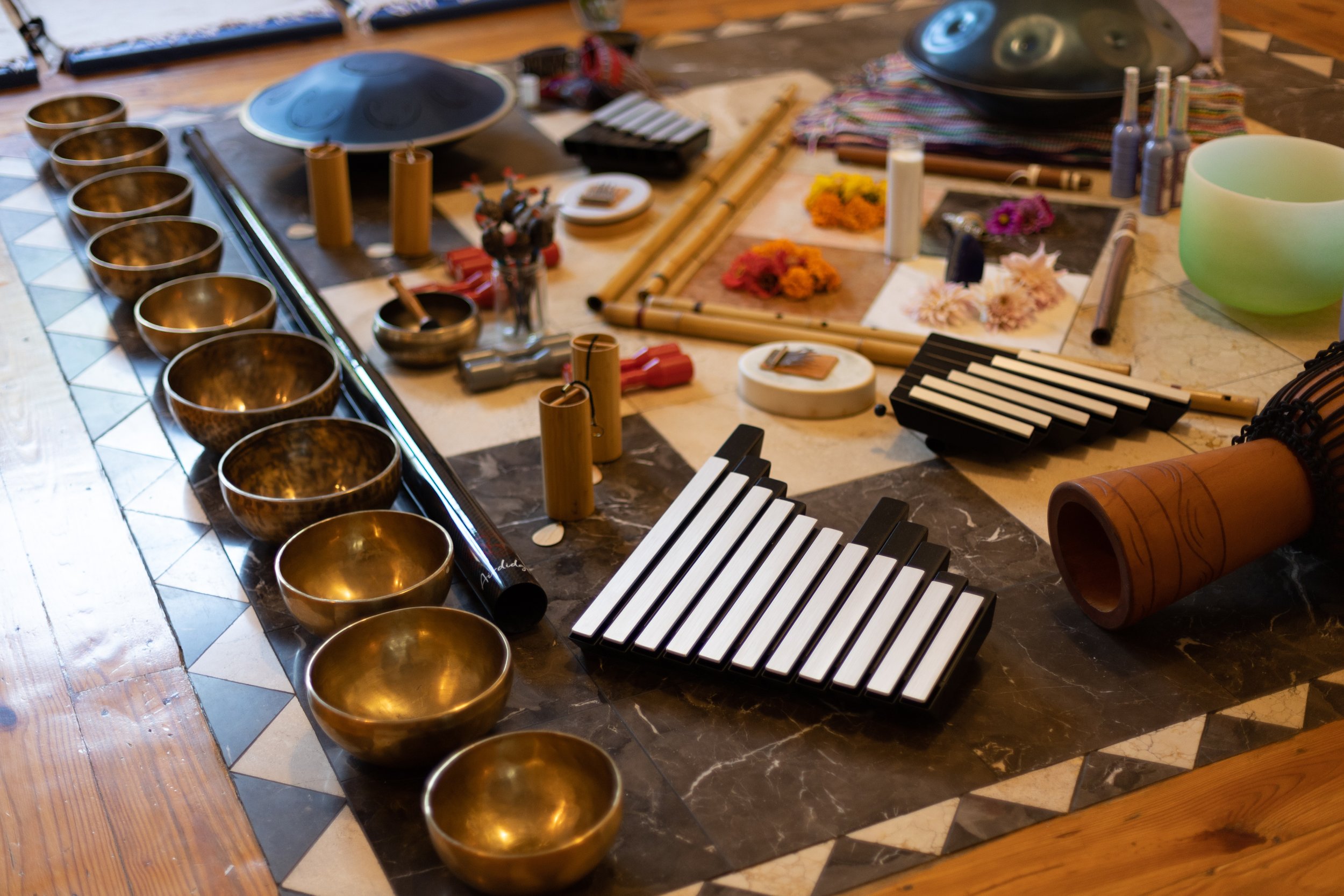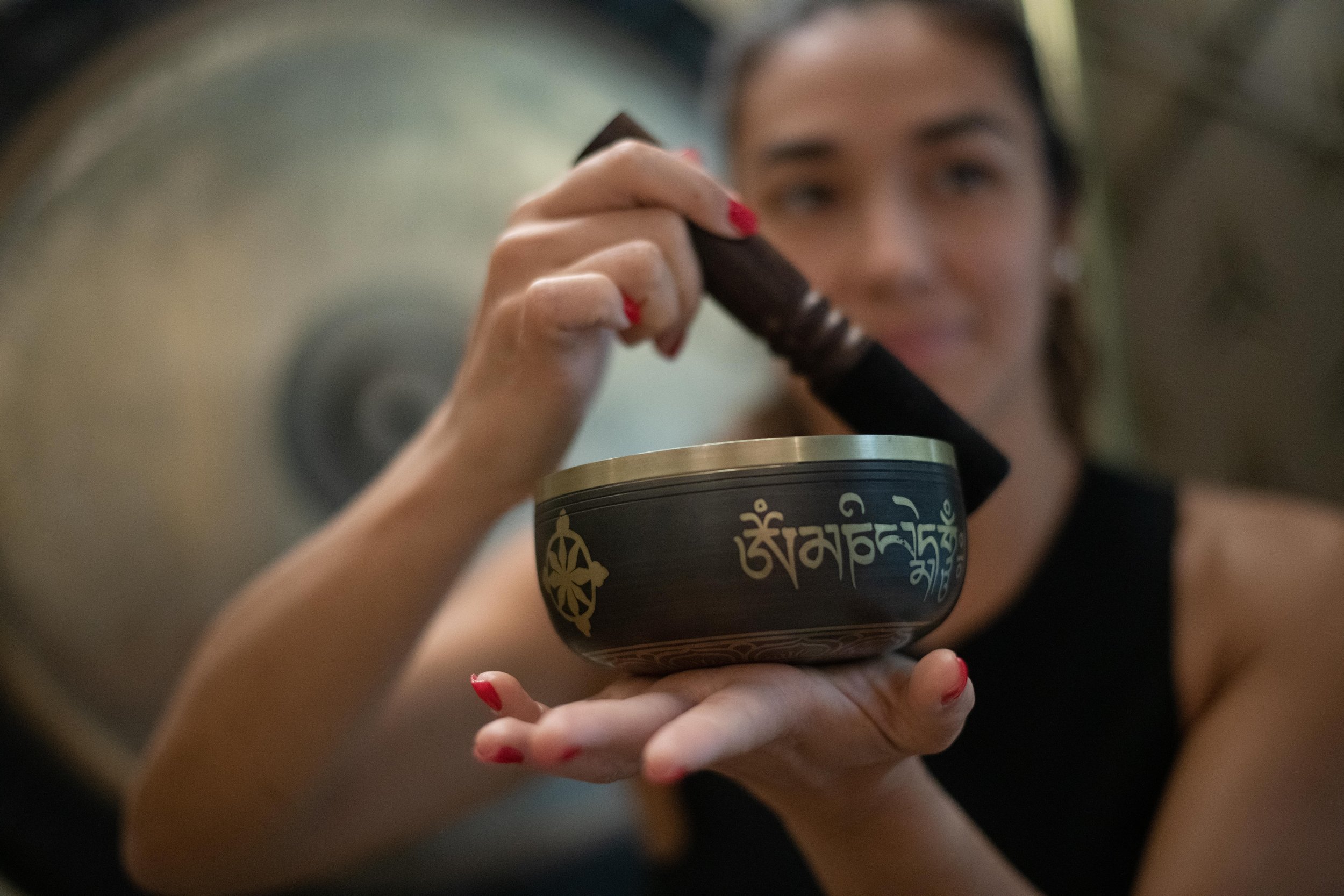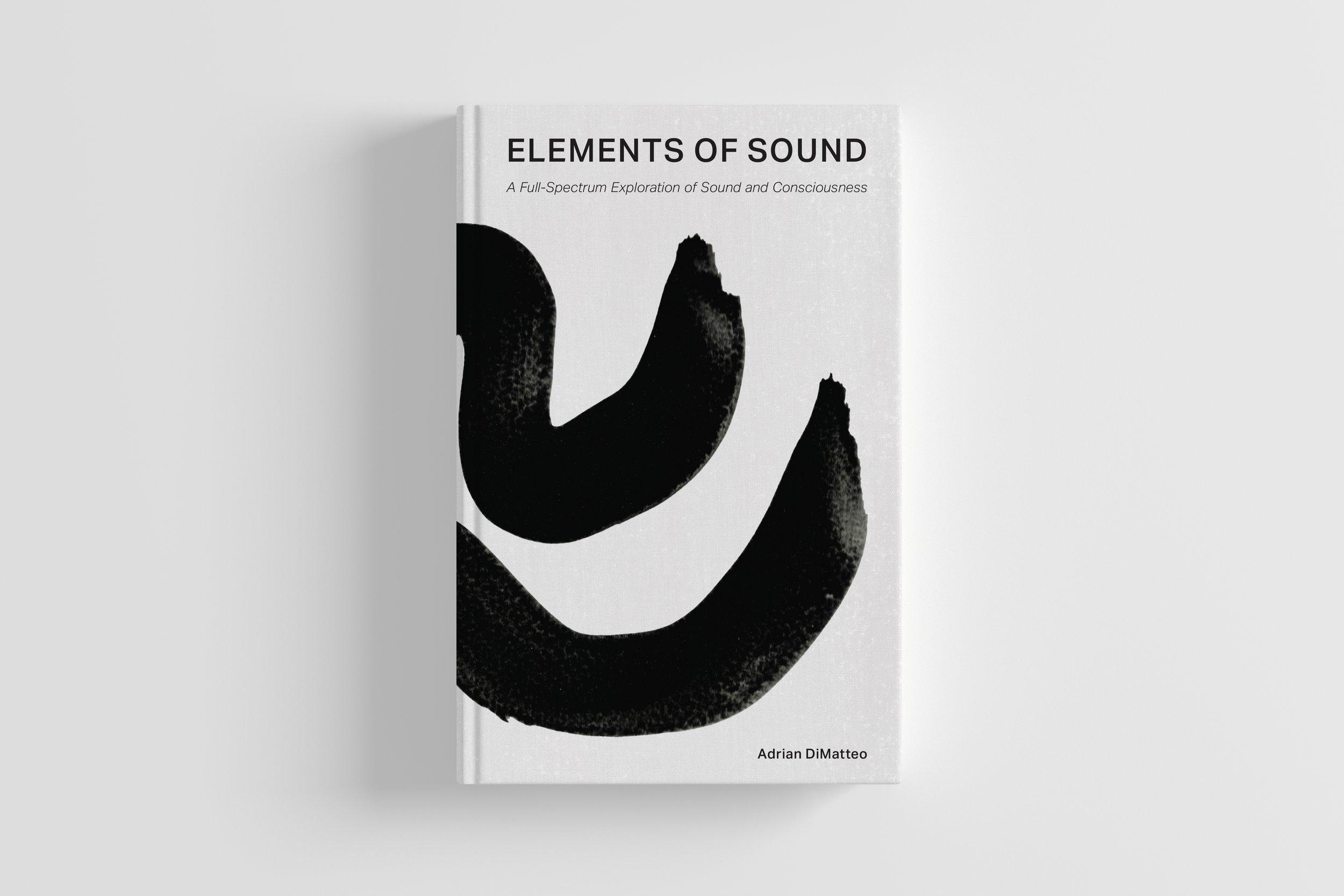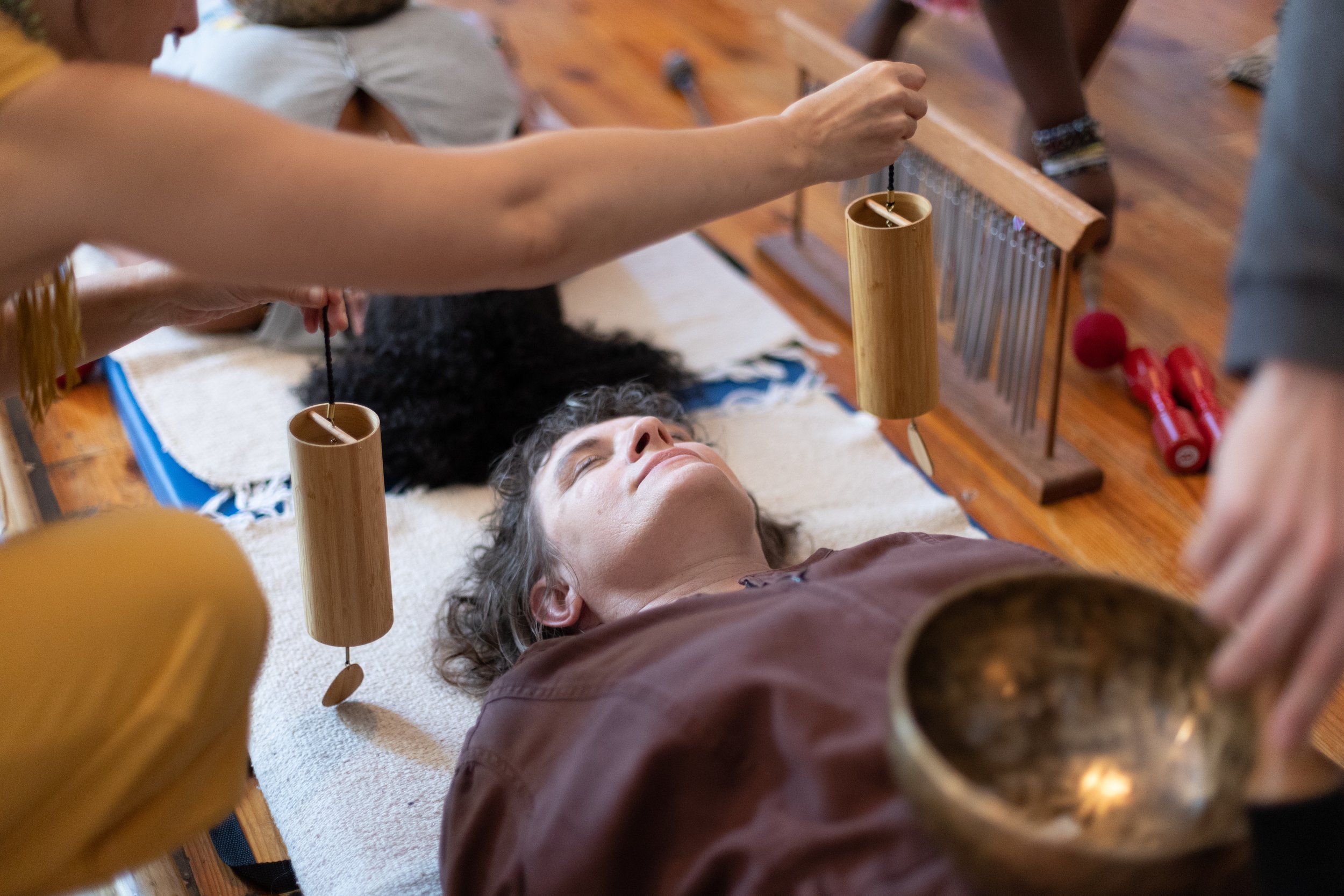
Sound as Medicine
Learn to facilitate sound healing and meditation experiences with confidence and integrity..
Are you looking to integrate sound healing and meditation techniques in your wellness practice? Our online training program features 10 episodes of high-definition content exploring sound, altar construction, hygiene for practitioners, healing techniques, training with the voice and a wide range of instruments.
Adrian DiMatteo—course facilitator and founder of the Sonic Institute— brings more than two decades of experience to this unique and profound offering. He has worked extensively in hospices, children’s centers, elder-care facilities and ceremonial settings around the world. DiMatteo is also a graduate of the world-renowned Eastman School of Music, author of Elements of Sound: A Full-Spectrum Exploration of Sound and Consciousness, and a retreat facilitator with years of experience in private and group healing and meditation sessions. His clear and sincere teaching style unites science, spirituality and music theory through a comprehensive approach to sound healing and meditation that is accessible to all people.
“Thank you so much for your time, energy and efforts and for this beautiful course. It was life changing!” — Elle, Course Graduate
“I have no words to describe how special this training was. I learned so much about healing and sound. I feel like it really helped deepen my practice in life.”
— Graduate, Sound as Medicine
This is for you if…
You’re called to incorporate sound and music more deeply in your life.
You’re inspired to offer sound healing and meditation experiences for others.
You want to develop greater freedom using your voice.
You want to enhance your healing practice (yoga, massage, acupuncture, ceremonial work, etc.) with elements of sound healing.
You're ready to explore your innate musical creativity.
You’re seeking practical guidance to facilitate sound healing and meditation experiences.
You want to understand essential musical topics such as rhythm, music theory and instrument combinations.
You want to explore the relationship between notes, tuning, chakras, and healing.
You want to learn more about altar construction and spiritual hygiene for healers and sound meditation practitioners.
What you will receive…
10 episodes of high definition video content (approx. 10 hours of content)
PDF files outlining how to facilitate sound healing and meditation experiences
Quizzes to help you assess your understanding of the course material
Vocal exercises that lead to greater confidence and freedom of self-expression (for both public speaking and singing)
Clear and practical instruction to get you started playing percussion instruments such as the frame drum, djembe and shakers
A comprehensive introduction to playing the pentatonic flute, one of the most ancient and widely encountered musical instruments in the world
The ability to articulate to others why and how sound and music can lead to improved quality of life
Sound as Medicine Course
Course Curriculum
-
Sound healing is a broad term that encompasses a variety of contemporary and traditional modalities. Diverse cultures have established an astounding variety of methods and protocols for facilitating sound meditation experiences. In this episode, we will explore some of the most universal principles of healing and meditation.
What we'll cover:
— Healing as Balance
— Single Point vs. Analytical Meditation
— Healing Altars
— The Four Directions and the Elements
— Cosmology of Sound
— Duality (sound and silence, giving and receiving, etc.)
— Science and Spirituality
— Physical, Emotional, Mental and Spiritual Bodies
-
In order to understand sound healing, we need to understand sound. In this episode, we will explore important principles of sound itself, such as the physics of sound waves and the way they interact.
What we'll cover:
— What are Herz (Hz) Frequencies?
— The 432 Hz debate
— Human Auditory Cognition
— Mechanical Pressure Waves
— Sonic Connotation (human listening bias)
— Infrasound and Ultrasound
— How are Notes and Chakras related?
— Overtones and Undertones
— Solfeggio Frequencies and Numerology
— White Noise and Environmental Sounds
— Scales, Funademntals and Microtones
— Octaves and Intervals
— Notes and Instrument Combinations
-
In order to understand sound healing, we need to understand sound. In this episode, we will explore important principles of sound itself, such as the physics of sound waves and the way they interact.
What we'll cover:
— Recorded Music vs. Live Sound
— Remote Sessions and Audio Technology
— Microphones and Spatial Audio
— Human Hearing Spectrum
— Hearing Damage
— Sound Physics
— Pre-recorded Audio in Sound Meditation
— Neurological Interpretation of Sound
— Soundscape Ecology
— Monophonic vs. Polyphonic Instruments
— Chords, Melodies and Scales
— Major and minor Tonalities
— Drones vs. Harmonic Movement
-
This episode provides a valuable window into the work of a sound healing facilitator in a real world one-on-one private session scenario. Adrian will guide you through important considerations to bear in mind as you learn to facilitate sessions, and provide clear demonstrations of how to combine instruments and use them on and around a person’s body.
What we'll cover:
— Preparing the Space
— Intention Setting
— Healing Herbs and Waters (aka smudging)
— Instrument Proximity
— Seated vs. Lying Down
— Transmutation through the Elements
— Chimes, Singing Bowls, Flutes, Gongs, Drums and more…
— Guided Meditation Example (yoga Nidra)
— Integration Strategies
— Hygiene for Healers
— Ethical Considerations and Waivers
-
Learning to facilitate a sound bath is one of the most important skills you develop through this course. There are many ways to do it, depending on your instrument collection, vocal training, spiritual background and overall approach to this craft. In this episode, Adrian masterfully demonstrates how to use a wide variety of instruments to create a sound journey designed to take participants on a profound inner meditation. Whether you watch the episode to observe how he uses instruments, or lie down and close your eyes to relax and receive the experience as a sound bath participant, there is lots to be gained from studying this full-length, uninterrupted demonstration.
What we'll cover:
— How to Introduce a Sound Bath
— Yoga Nidra (Conscious Relaxation)
— Inspiration for Instrument Combinations
— Hour-long Sound Bath Demonstration
-
“If you can walk, you can dance. If you can talk, you can sing.” — African Proverb
The voice is the first instrument. Learning to sing, while it is partly an artistic and technical craft to create beautiful things, is about empowering your authentic voice/self so you can be more fully and truly expressed.
You will learn vocal exercises and techniques to improve tone, volume control, range, clarity and power, as well as teachings related to the diet of the voice, and how to use your heart with your voice to connect with the throat chakra. Singing is deeply connected with creativity and communication.
The esophagus is one of the first parts of the human body that develops in utero. The physical, emotional, and psychological environment we are formed in can have a major impact on our ability to communicate and express ourselves freely.
This episode is committed to creating a safe space for you to connect with your voice, release fear and shame, and to realize that you have unique, powerful, and healing vibrations inside of you. Through vocal exercises and mantras, you will connect with the diaphragms, muscle groups, and energy centers of the body involved in producing sound. We will increase our awareness and control of these areas, and realize how clear and authentic self-expression can strengthen and improve our communication in all areas of life.
What we'll cover:
— Essential Vocal Anatomy
— Psychology of the Voice
— Relevance of the Throat Chakra
— Posture and Breath Considerations
— Works for all Genders and Voice Ranges
— Vocal Warm-Ups
— Useful Vocal Exercises
— Develop Pitch Control (singing “in tune”)
— Exercises to Enhance Breath Support
— Major and minor scale exercises
— Solfege (Do, Re, Mi, Fa, So, La, Si/Ti, Do)
-
Archaeologically, the flute is among the oldest instruments known to humanity, with mammoth bone ivory flutes dating back over 40,000 years. A wide variety of flutes are found throughout the world, making it one of the most widespread sound healing instruments.
Learning to play the flute is a powerful way to connect with the breath. At once meditative and healing, oxygenation also provides a range of benefits for the brain and the entire physical body.
Learn breath control and fingerings for a variety of traditional flutes from around the world, such as Native American flutes, bansuri, quena, shakuhachi, overtone flutes and more. Message us to find out if we can help with your particular flute.
What we'll cover:
— Breath Control Exercises
— Learn Fingerings for Native American Style Pentatonic Flutes
— Hear a Variety of Flutes from Around the World for Inspiration
— Learn to Improvise on a Native American Style Flute
— Learn How to Apply Rhythm to the Flute
Note: Native American Style Flutes can be purchased through the Sonic Institute. We carry a rotating stock of exquisite hand-made bamboo flutes from Master craftsmen in Peru. Contact us at info@sonicinstitute.com for more information.
-
Rhythm is fundamental to music. The definition of a melody is: notes over time (M=N/T). Understanding how to navigate time is one of the most important steps you can take on your musical journey. In this episode, you will learn important theory and practical exercises to develop functional rhythmic skills and mastery of essential concepts.
What we'll cover:
— Essential Music Theory related to Rhythm
— Time Signatures
— Tempo
— Learn to Use and Practice with a Metronome
— Understand How to Apply Rhythms to a Variety of Instruments
— Clapping and Stepping Exercises
— Guided Audio Exercises
-
There are countless instruments available to the modern-day sound healer. Today, you have unprecedented access to instruments from around the world. In this episode, you will encounter a wide variety of instruments commonly found in the sound healing world. This episode also features an immersive audio meditation to experience a variety of spatial effects and frequencies these instruments can produce.
What we'll cover:
— Instrument Properties
— Spatial Awareness
— Bells
— Chimes
— Crystal Instruments
— Rainsticks, Shakers, Rattles and Leaves
— Gongs
— Singing Bowls
— Tuning Forks
— Xylophone
— Other fun goodies…
-
Experience is a great teacher. One of the benefits of learning from an experienced practitioner is exposure to real-world reflections from a person who has walked the path. In this episode, Adrian shares stories and insights from over 20 years in the music world, including his extensive encounters with indigenous cultures, initiatic training and while on pilgrimage.
What we'll cover:
— What is the difference between musical performance and sound healing?
— How do you ethically source musical instruments?
— How can science and spirituality be united through music?
— How do you deal with doubt and letting go?
— How is sound and music used in other cultures?
— Why is lifestyle important to a sound healer?
— How should someone prepare for a sound healing experience?
— How should a student get started offering sessions to people?
Meet Adrian…
Adrian DiMatteo (B.M. Eastman School of Music, 2012) is the founder of the Sonic Institute. He is an international performing and recording artist, author (Elements of Sound: A Full-Spectrum Exploration of Sound and Consciousness), music educator, app creator (Chord Atlas), and sound meditation facilitator with over 20 years’ experience in the music world. Adrian has toured and traveled extensively—exploring sound, language, musical culture and how they affect individual and collective wellbeing. Hundreds of students have graduated from Sound Healer Training programs and weekend retreats that Adrian regularly facilitates nationwide. To date, he has offered musical experiences to thousands of people in hospitals, hospices, elder care facilities, prisons and children’s centers.

“Sound healing instruments and practices are nothing less than sophisticated surgical tools in the hands of a qualified facilitator.” — Elements of Sound
BENEFITS OF SOUND:
Playing music requires creativity, imagination, focus and coordination. Learning an instrument and practicing music enhances these capacities. Psychologically, music provides a means of nonverbal communication, providing an outlet for connecting with and expressing emotion. As a safe and healthy activity, it can help deemphasize obsessive thinking and compulsive behavior. As a non-invasive treatment, sound and music therapies promote relaxation and reduce pain while reducing or eliminating the need for pharmaceutical medications and their associated side effects.
-
Music cognition involves more parts of the brain than virtually any other activity, affecting:
Memory (hippocampus)
Motor skills and spatial awareness (cerebrum, cerebellum, motor cortex, sensory cortex, and visual cortex)
Linguistic and auditory processing (auditory cortex, cerebellum, prefrontal cortex)
Emotional processing (limbic system, nucleus accumbens, amygdala, and the cerebellum)
-
Sound waves tangibly impact the physical body in many ways, depending on whether they are passively received or actively produced:
Stimulation of the vagus nerve (affects digestion, heart rate and immune function)
Promoting coherence between the electromagnetic fields of the heart and brain
Regulation of the circulatory system
Regulation of the endocrine system
Regulation of the sympathetic, parasympathetic and autonomic nervous systems
Infrasound and ultrasound have numerous medical applications
Cellular and molecular “massage” when sound waves penetrate the physical body
-
Simply put, music is a deeply human activity (although not limited to the human species). Musical practices and traditions are distinguishing aspects of culture and are deeply interwoven with cosmology and community life. In that regard, shared music-making and dance can promote meaningful relationships and connections within and across social groups, leading to an improved quality of life, shared values and sense of belonging.
Due to the interwoven mental, physical and emotional aspects of music cognition, music-making lies at the intersections of art, psychology, philosophy and science. Because of this, music therapies are well positioned to promote balance on all levels and provide access to cathartic and transcendental experiences.
Course Plans
FULL COURSE
Includes 10 episodes. PDF Files & Quizzes. Lifetime Access. Certificate of completion. Access to Circle community.
$500
INDIVIDUAL LESSONS
Choose which modules are right for you. Learn at your own pace. Lifetime Access.







